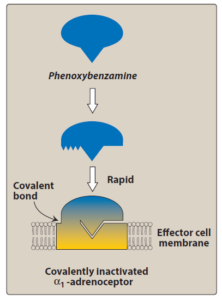- Phenoxybenzamine is non-competitive antagonist of alpha (alpha-1 and alpha-2) receptor. It causes irreversible blockade of these receptors.
- Phenoxybenzamine is classified chemically as haloalkylamine. It got its approval for medical use by United States Food and Drug Administration (FDA) in 1953. It is also available in generic forms.
Indications of phenoxybenzamine
- For treatment of hypertensive crisis in patients with pheochromocytoma. Pheochromocytoma is tumor of adrenal medulla in which large quantities of epinephrine and nor-epinephrine are produced.
- During surgical treatment of pheochromocytoma, hemodynamic instability may occur. Phenoxybenzamine can be used preoperatively to prevent this.
- Some of its additional (off-label) uses are: in benign prostatic hyperplasia (rarely used due to unfavorable side effects), in hypoplastic left heart syndrome, in complex regional pain syndrome (CRPS) type 1.
- Off-label uses include for controlling manifestations of autonomic hyperreflexia in patients with spinal cord transection.
Mechanism of action of phenoxybenzamine

Figure 1- Covalent inactivation of alpha-1 adrenoreceptor by phenoxybenzamine (source-Lippincott’s Ilustrated Reviews, Pharmacology)
- It is a prodrug which is converted to active metabolite. It binds covalently to alpha-1 and alpha-2 adrenergic receptors leading to long-lasting, non-competitive blockade of these receptors. Thus, it reduces the vasoconstriction caused by epinephrine and nor-epinephrine leading to anti-hypertensive action.
- The blockade is irreversible and only way to overcome is to synthesize new adrenoreceptors. This is the reason for its long duration of action. After the injection of drug, delay of few hours occur before a blockade develops.
Pharmacological Actions of phenoxybenzamine
Cardiovascular actions
- It blocks α receptors and prevent vasoconstriction of peripheral blood vessels caused by catecholamines. It causes a progressive decrease in peripheral resistance and increase in cardiac output. Increase in cardiac output is due to blockade of presynaptic inhibitory α-2 receptors.
Epinephrine reversal
- It reverses the α agonistic activity of epinephrine. Hence, in presence of phenoxybenzamine, systemic blood pressure decreases in response to epinephrine. The action of nor-epinephrine is not reversed but are decreased in presence of phenoxybenzamine as norepinephrine lacks significant beta agonist activity.
- In normal doses, there is slight lowering of BP in normal people whereas BP is significantly lowered in patients with pheochromocytoma.
Miscellaneous
- It blocks the action of acetylcholine (ACh), histamine and serotonin (5-HT) in higher doses. Slow IV infusion produces drowsiness and sedation (due to its anti-histaminic activity).
Pharmacokinetics
- Its oral absorption is irregular. When administered through SC or IM route, it produces irritation so oral and IV route is preferred.
- It’s accumulation may occur body fat due to high lipid solubility. The blocking effect starts 1-2 hours after administration and has long duration of action of about 3-4 days.
Adverse effects
- Major adverse effect is postural hypotension often followed by reflex tachycardia and other arrhythmia. Hypotension is severe in hypovolemic patients.
- It can cause nasal stiffness, nausea, vomiting, palpitation and giddiness. Other adverse effects include inhibition of ejaculation, dryness of mouth and miosis. In large doses, can cause excitability and convulsion. It can cause cumulative toxicity.
Preparation and Dosage
- It is available as 10 mg capsules. For operation, standard therapy is to initiate at 10 mg twice a day for 1-3 weeks before the operation until desired effect is observed.
- For prolonged treatment in inoperable or malignant pheochromocytoma, the usual daily dose is 40- 120 mg in 2-3 divided doses.
Contraindication
Contraindicated in following conditions
- In patient allergic to phenoxybenzamine.
- In recovery period during myocardial infarction and cerebrovascular accidents.
- It should be used with caution in patients with cerebrovascular disorder, congestive heart failure, arthrosclerosis and renal impairment.
- Used with caution in children and pregnancy and contraindicated in breastfeeding mothers.
References
- Mario A. Inchiosa Jr. Phenoxybenzamine in Complex Regional Pain Syndrome: Potential Role and Novel Mechanisms. Anesthesiology Research and Practice. 2013; 978615: 1-7.
- A. van der Zee, A. de Boer. Pheochromocytoma: A review on preoperative treatment with phenoxybenzamine or doxazosin. Netherlands The Journal of medicine. 2014; 72(4): 190-201.
- Mario A, Inchiosa Jr. Anti-tumor activity of phenoxybenzamine and its inhibition of histone deacetylases. PLoS One. 2018; 13(6): e0198514.
- Pharmacology and Pharmacotherapeutics. 24th edition.
- Goodman and Gillman Manual of Pharmacology and Therapeutics.
- Lippincott Illustrated Reviews Pharmacology. 6th edition.